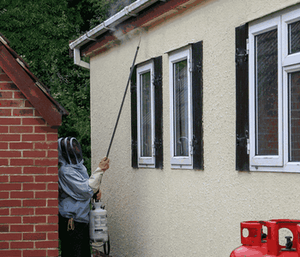Wasp nest control - how we kill wasp nests?
When faced with a wasp nest, your initial question is likely, "How can I effectively remove it?" Dealing with a wasp nest presents a unique challenge. Besides the obvious risk of getting stung, simply pulling it off and discarding it is not a viable solution.
Another concern arises if you remove the nest: how do you handle the foraging wasps not inside the nest during the removal? It's common for wasps whose nests have been destroyed to start rebuilding from scratch.
Don't panic; we specialize in both wasp nest control and hornet nest treatments. We strive to offer same-day service whenever possible. So, for those who have an aversion to wasps, rest assured that we are here to assist and guarantee the effective elimination of your wasp nest.

Nest treatment process
To provide you with a clear understanding of our approach to wasp nest control, we've outlined the process for you:
Upon arriving at your home for the wasp nest treatment, we meticulously identify all entry points to the nest or, if feasible, locate the nest itself. Seeing the nest is not always necessary for effective elimination, as we employ an insecticide that ensures the complete eradication of the nest.
Our insecticides are exclusively for professional use and rely on either bendiocarb or permethrin. It's important to note that bendiocarb is being phased out over this year (2024). While new liquid insecticides are emerging, it's crucial to highlight that these may not be suitable for indoor use. Additionally, there is uncertainty regarding replacing bendiocarb and how it will impact our procedures once it is no longer available. Our commitment to staying informed ensures that we adapt our methods to meet the highest safety and efficacy standards.
Using a pressurized applicator, we apply the insecticide under pressure, directing it into the nest entrances. If the nest is visible, we can also stab and inject the insecticide directly into its interior.
As wasps return to the nest, they inadvertently carry the treatment into it, contaminating all occupants. Simultaneously, a lethal dose of the insecticide is blown into the nest. The insecticide acts swiftly, and the nest typically succumbs by the end of the day, often even sooner, once all inhabitants return from their daily activities.
After treatment
After treatment, the wasps may become agitated due to the application process. As a precaution, we recommend that customers keep children and pets indoors and all windows and doors closed briefly following treatment. This is to ensure everyone's safety, as the last thing we want is anyone getting stung when such incidents are easily preventable.
When you request our assistance for a wasp nest, guide us to the nest location and maintain a safe distance while we do the treatment. This approach to wasp nest control is consistently the safest method for dealing with wasps or hornets, regardless of the nest's location.
It's worth noting that we have a flawless record of successfully treating nests, and there has never been a nest that we couldn't manage. Your safety and satisfaction are our top priorities throughout the entire process.
FAQ's
We often get asked:
-
Do wasps nest in trees and bushes?
Answer: Yes, German wasps build nests in trees and bushes.
-
Do wasps nest underground?
Answer: Yes, common wasps construct nests in old vole and rabbit burrows, under walls, patios, or any dry space with enough room for nest building.
-
How can you tell if a wasp nest is active?
Answer: Watch the nest from a safe distance. An active nest will show wasps leaving and returning, with activity on the exterior as they make repairs and add nest material. Check our wasp nest videos for visual examples.
-
What about small "starter nests" in sheds or lofts?
Answer: If found in late summer (July onwards), smaller nests (up to 3 inches in diameter) are likely inactive. Nests larger than 3 inches could be active in late June/early July. For further information, please look at our wasp nest videos.
-
How do I know if I am allergic to wasp and bee stings?
Answer: You'll be aware if you are allergic when you find yourself in an ambulance heading to the hospital after a sting. For any wasp-related issues, we offer a fast, friendly, and safe solution to prevent the discomfort of a nasty sting.
Whatever your wasp problem is, we can deal with it for you quickly, friendly and safely, preventing anyone from going through the discomfort of having a nasty sting.

